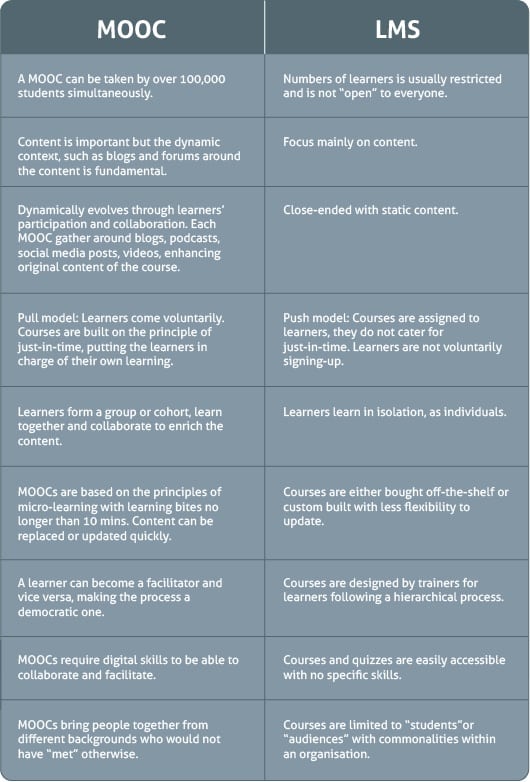
MOOCs (Massive Online Open Courses) first emerged in 2008 but became widely known when Stanford University released their first open-enrolment course in 2012. Since then, MOOCs have become hugely popular and are offered by leading universities from Harvard to Oxford.
But as MOOCs take the education world by storm, one question remains – can they be used in a corporate training environment?
MOOCs vs LMSs: the key differences
Below is an overview of differences between MOOCs and online courses.

What are the opportunities for workplace learning?
Incorporating MOOCs within businesses will challenge the way human resources and corporate learning departments historically work, but many see the positive opportunities. In a survey from Future Workplace, completed by 195 HR and corporate learning professionals, 70% agreed they could see the possibilities of integrating MOOCs into their own training programs.
Many MOOC features are indeed well suited to the corporate world:
- Flipped classroom: The concept of doing the training at home and applying the knowledge in the classroom can be easily adapted for businesses. It allows learners to have a wider role and be more engaged.
- Analytics: MOOCs provide real-time analytics that not only reveals learners’ progress but what formats work best for them.
- Credentials: Many MOOCs offer college credit or certificates which “formalise” the learning. In the workplace, where employees are demanding more opportunities for CPD, certificates can become an incentive for them to complete training as they’ll be able to keep evidence of their work.
- Social learning: Sharing, networking, blogging – all are a key part of MOOCs. Some LMSs such as Totara have already recognised the importance of social learning by introducing it to their platform.
- Blended approach: MOOCs can be used to complete in-house training. Employees can take a MOOC for general training and carry out their more in-depth training on the company’s LMS. Ultimately, this reduce the cost of training and budgets can be reallocated.
Of course, the opportunities go much further because they are not limited to HR departments anymore. By integrating MOOCs with their standard LMS, organisations can add value by using the platform as a marketing and sales tool which carries their brand and engages all their stakeholders, from personnel to partners, users and customers.
Success story
Webanywhere successfully integrated a MOOC within a traditional LMS for one of their customers, a US fortune 500 healthcare company.
The company wanted to consolidate their two global educational sites. Working closely with them, we developed a MOOC platform which provides personalised, relevant, and interactive education where healthcare professionals can learn more about the organisation’s products and therapies. The system offers a wide range of courses, PowerPoints, procedural videos, and webcasts.
The platform is a powerful ecosystem of learning technology solutions which offers users a powerful MOOC experience that standard LMSs do not usually provide. It is used by internal and external stakeholders and actively promotes their brand globally.
This is a true success story of how a large organisation has integrated the MOOC concept within a more traditional LMS approach.
Finally
The learning management market continues to evolve. There are more than 500 LMS providers worldwide and open-source platforms such as Totara, which offer more flexibility and customisation than other “off-the-shelf” systems, have already improved users’ experience. With the explosion of MOOCs, social learning and micro-learning, corporate training must catch-up with the education sector and embrace the new trends.
Sources:- https://idreflections.blogspot.co.uk/
- www.futureworkplace.com
- www.forbes.com

